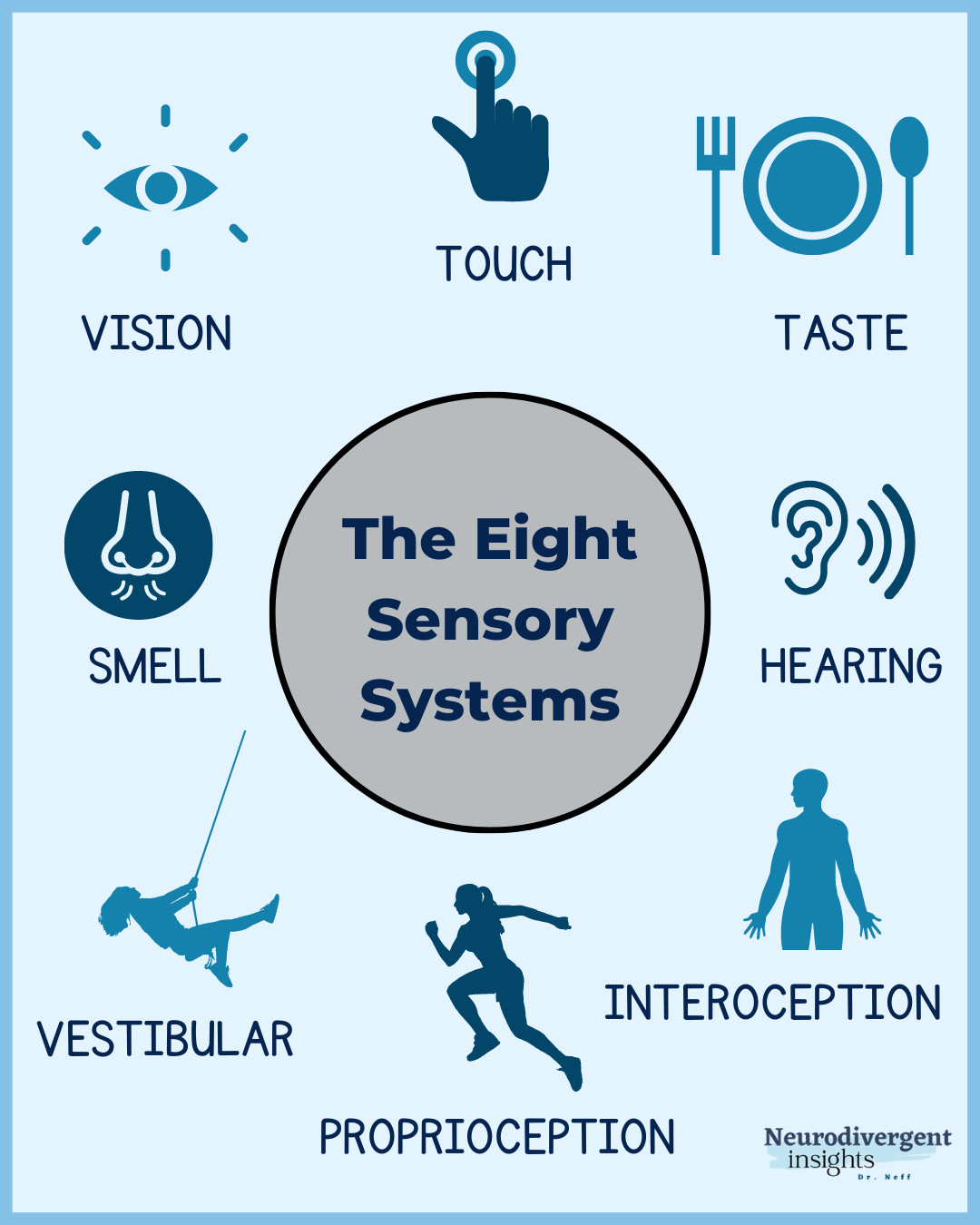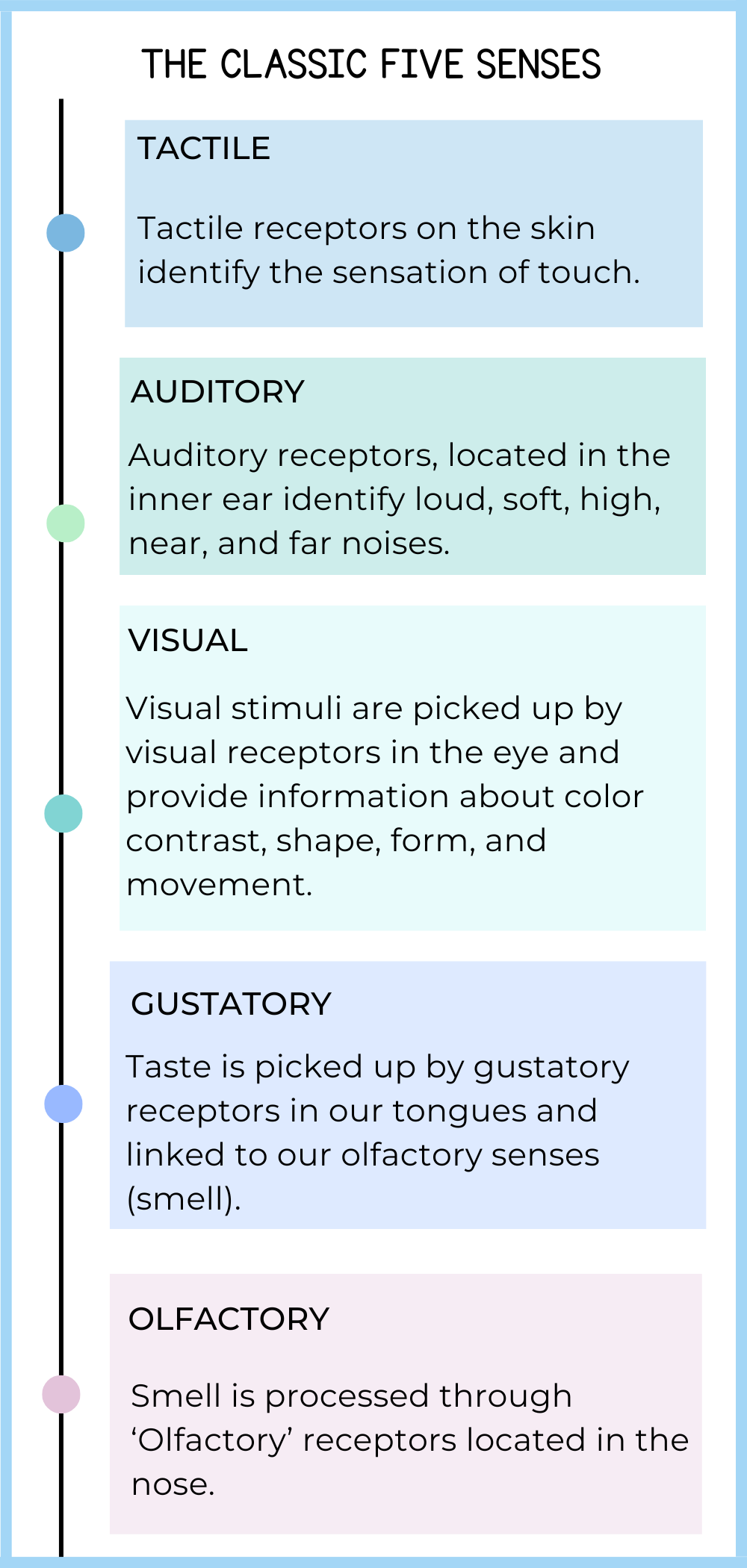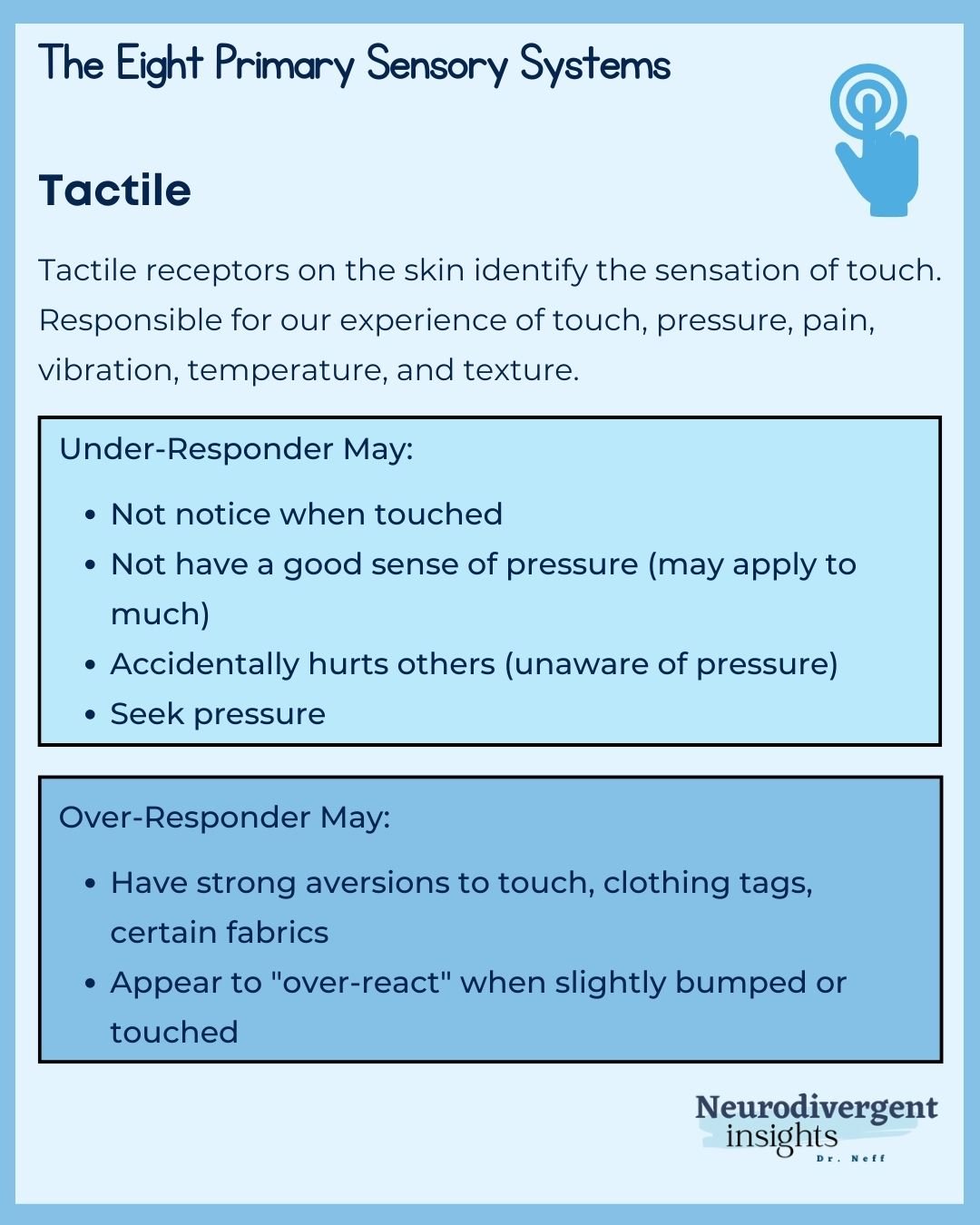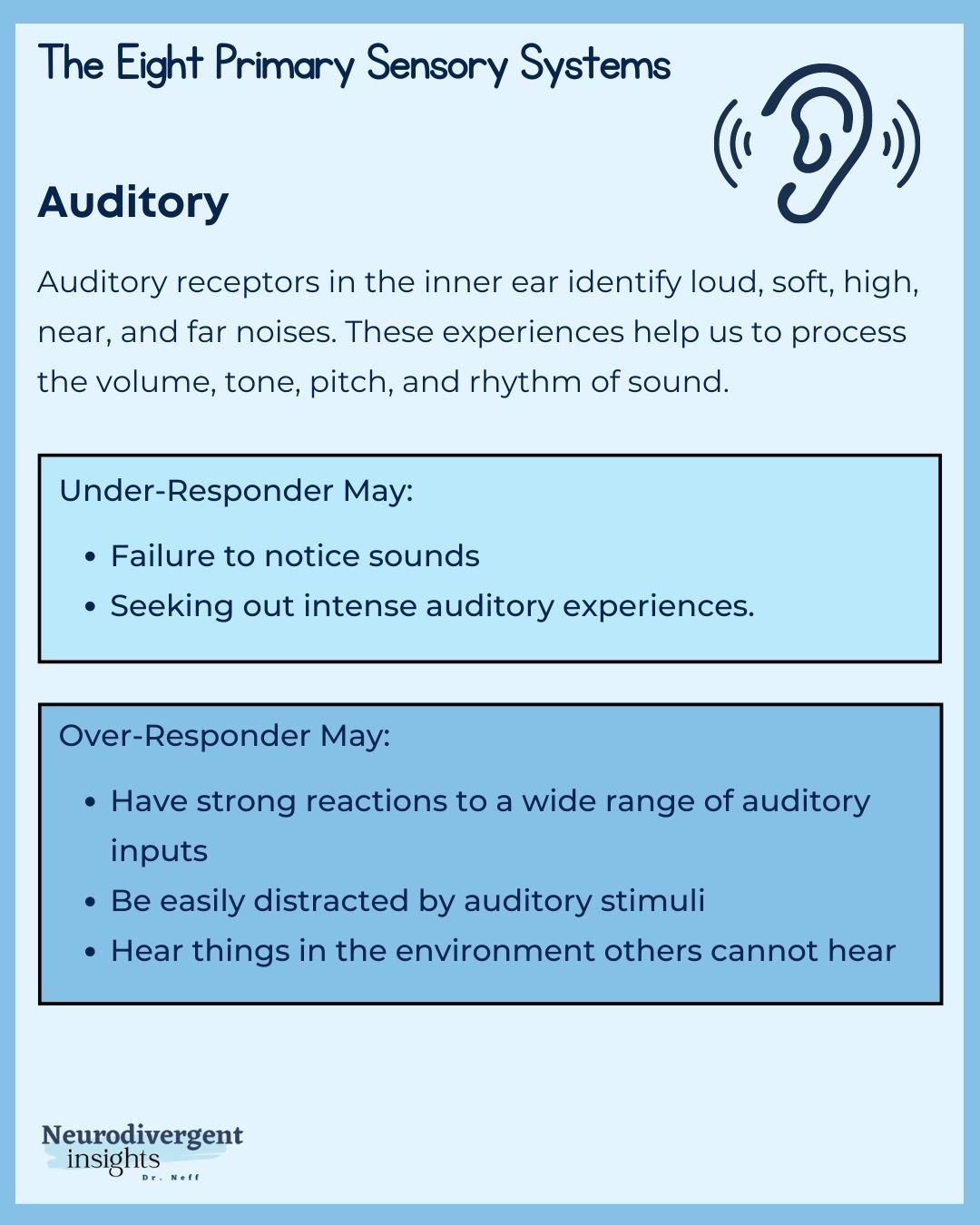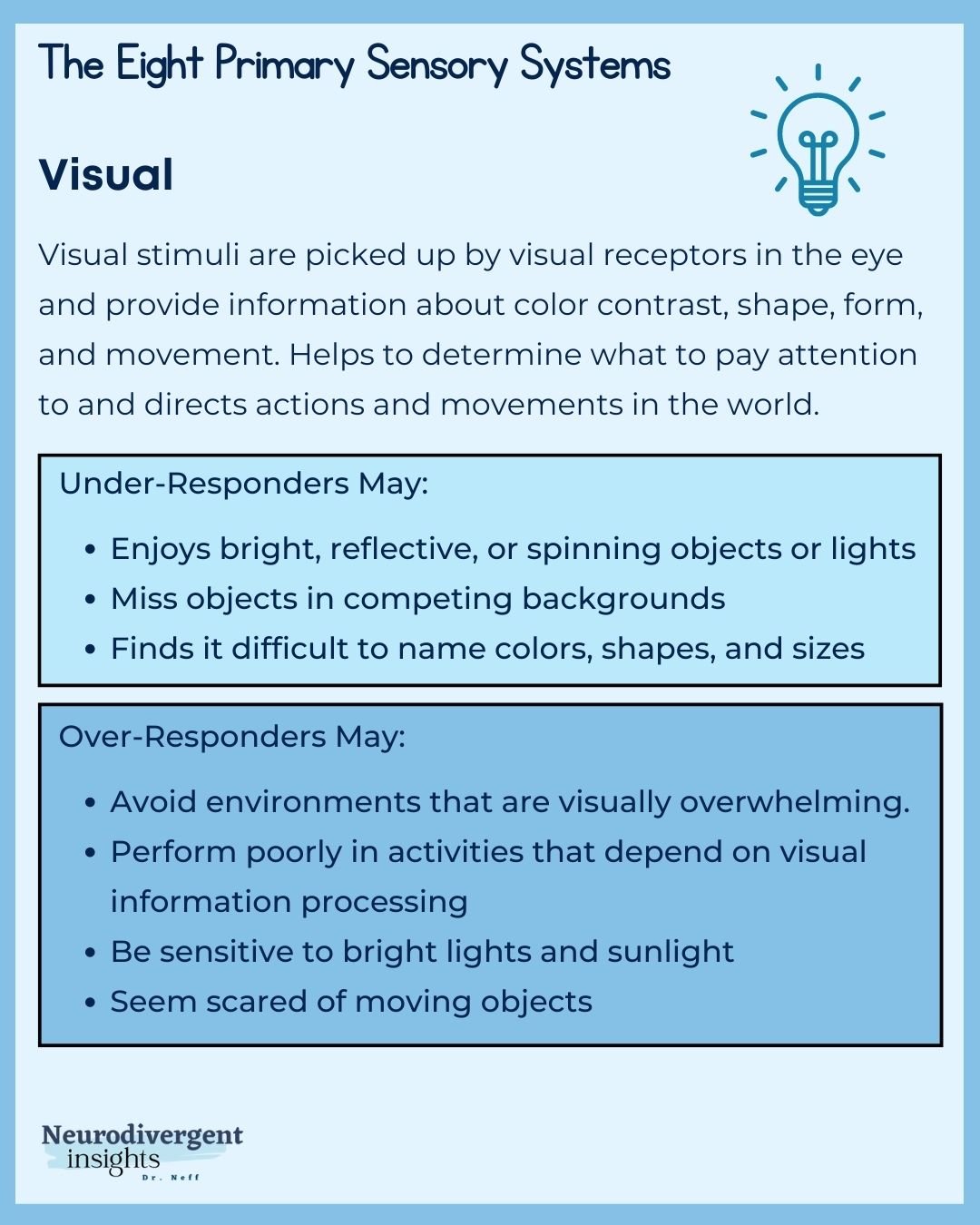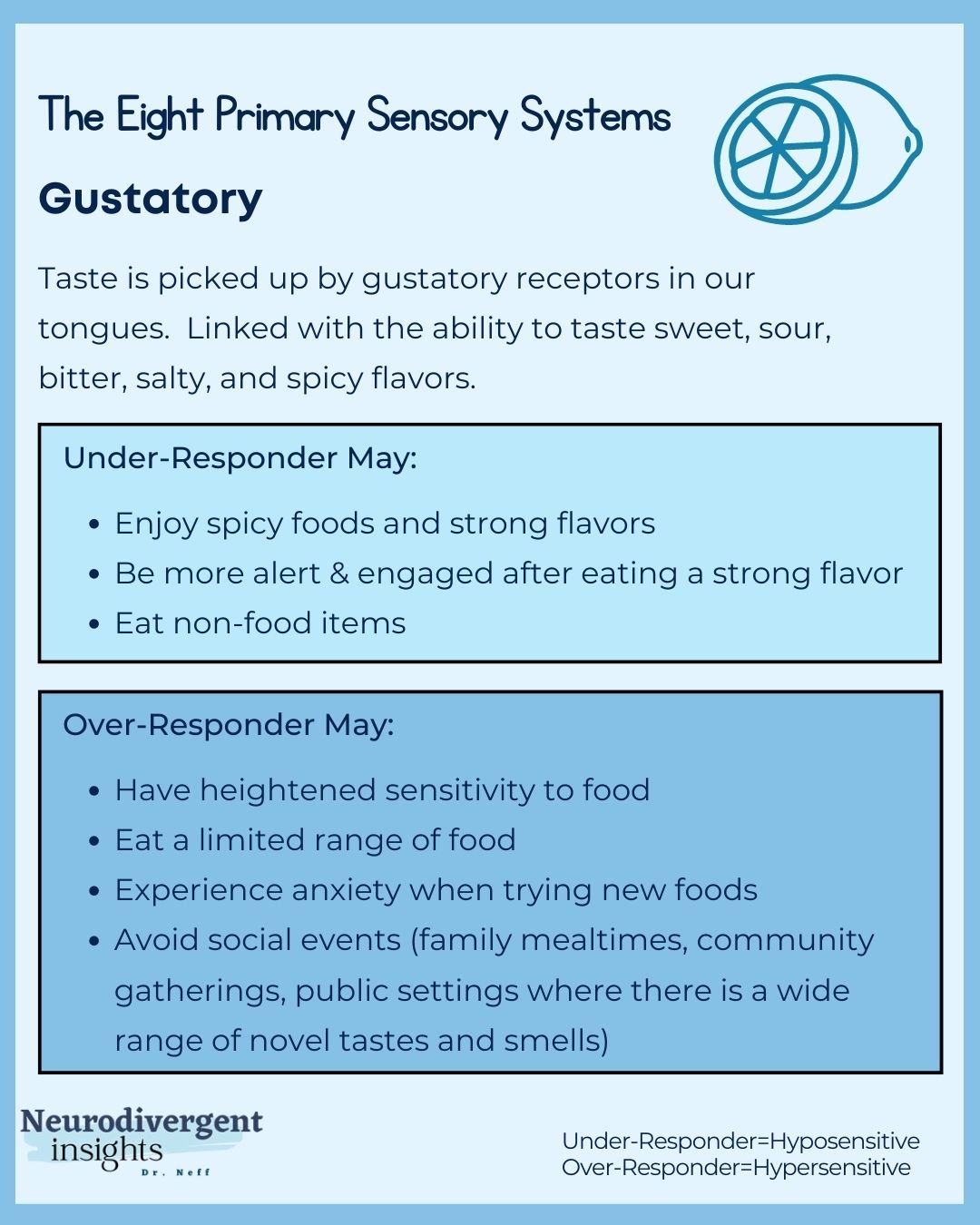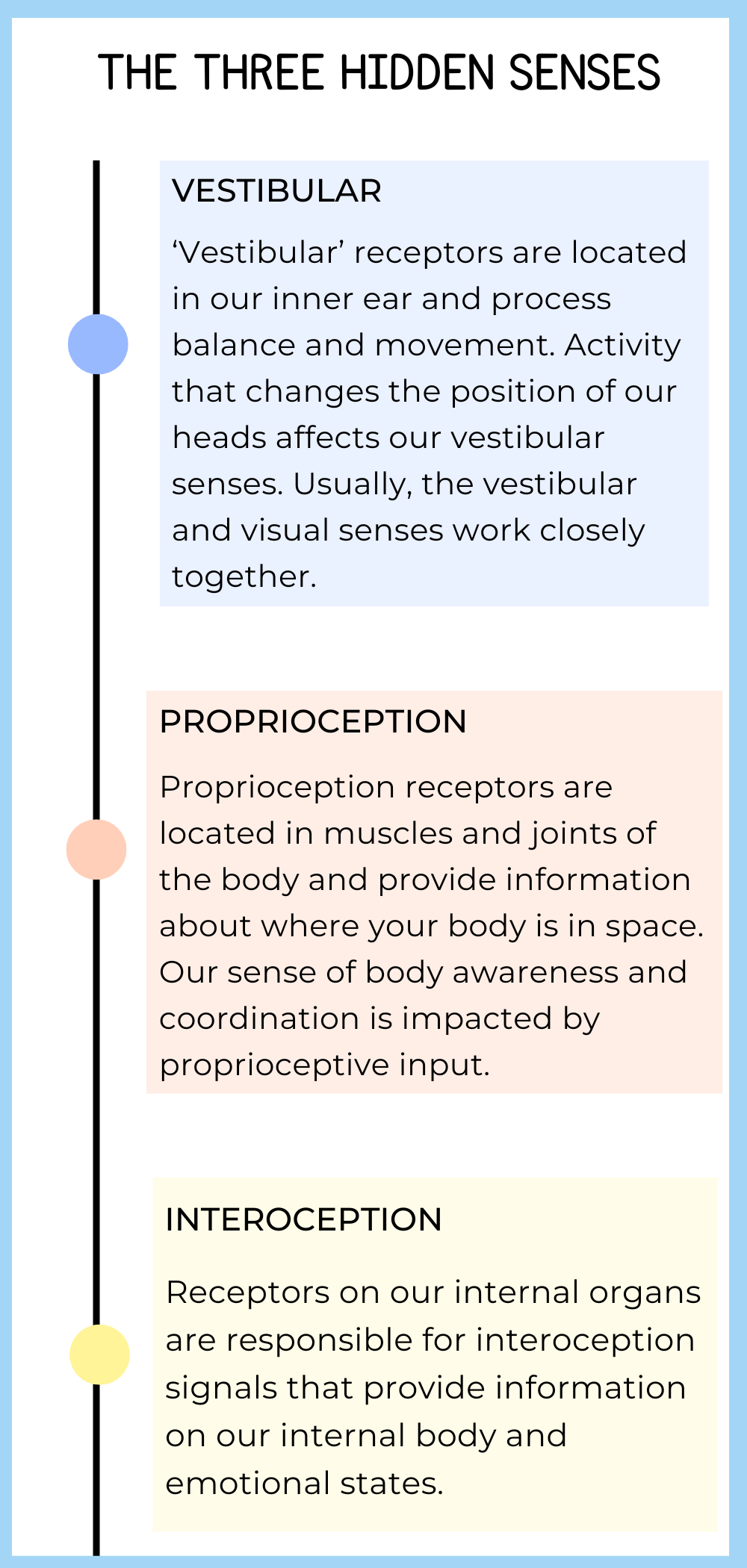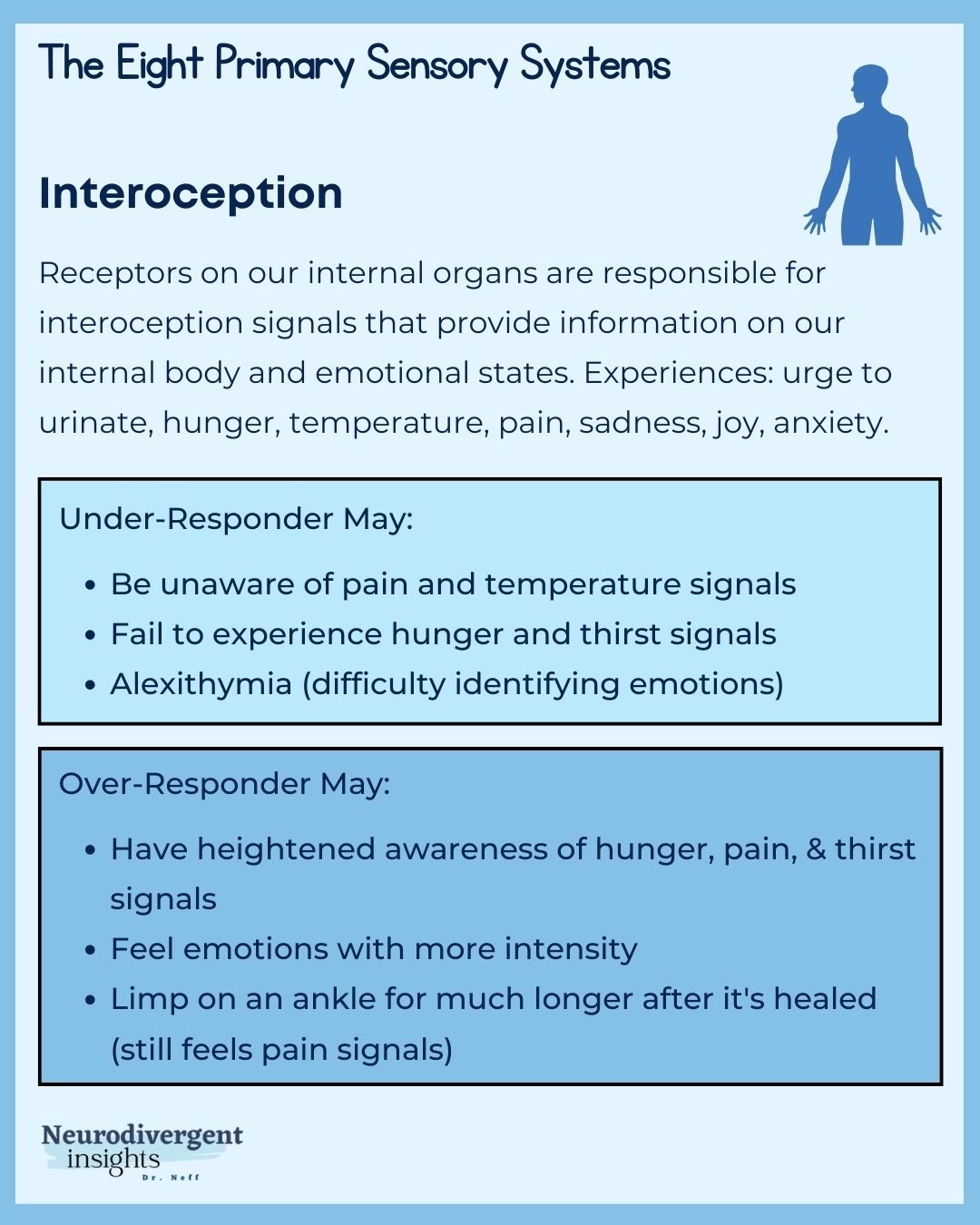8 Senses of the Body: the Hidden Sensory Systems
Disclaimer: Some of the links included in this article are affiliate links, meaning that at no additional cost to you if you click through and make a purchase, I will earn a small commission.
Have you ever been stuck in an elevator with someone with cologne or perfume and developed a headache? Do you intentionally avoid the detergent aisle in the grocery store? Or the grocery store altogether? Do fluorescent lights make your head pound? If your notice yourself cringing as you read those descriptions, I imagine you're someone who lives with sensory sensitivities. If you live with sensory disabilities understanding your eight senses and learning how to work with your eight sensory systems is vital. The more we understand our sensory systems, the better we can support ourselves and communicate our needs.
Between 5-15% of people have a sensory processing disorder, and this rate is higher among ADHDers and Autistic people (Miller et al., 2017). As someone with sensory processing disabilities, I have firsthand experience of the disruption sensory processing issues can create. Once I was diagnosed Autistic-ADHD and began understanding my sensory profile, I could work with it for the first time. I created accommodations to support my auditory, visual and tactile sensitivities and was able to better communicate with my family and friends about my sensory needs. When I finally considered my sensory experience of the world, a new world opened up. As a Psychologist, I am frequently considering the sensory experience of my clients. Once I had this lens for understanding peoples’ experiences it opened up a whole new way of understanding everyday experiences and struggles. Looking through everyday situations through a sensory lens can be deeply empowering and can unlock many new supports.
In this article, I will:
Provide an overview of the 8 sensory systems, including the five physical, sensory systems, and the three hidden systems
Provide an overview of over-responders and under-responders
Discuss accommodations and strategies to work with each sensory profile
The 8 Senses and Sensory Systems
Our experiences of our bodies and environment are intimately shaped by our sensory systems. How our minds and bodies integrate sensory information plays a big role in everyday tasks. It influences our ability to self-regulate, interact with others, and accomplish basic tasks in living.
For a long time, it was believed we have five primary sensory systems (touch, smell, taste, visual, and sound). Over the past several years, there has been increasing awareness of the three "hidden" sensory systems. These three hidden sensory systems include the vestibular, proprioception, and interoception systems.
When a person has sensory processing differences, they may be hyposensitive (under-responsive) or hypersensitive (over-responsive) to sensory input. Complicating matters, a person may be hyposensitive in one sensory system and hypersensitive in another. For example, I am hypersensitive to touch, sound, and smell and hyposensitive to taste. For this reason, it can be helpful to "map your sensory profile" and become intimately aware of where your sensitivities are (identifying what your triggers are and what your sensory helpers are). Following is a description of each sensory system and examples of hyper and hyposensory processing.
The 5 Classic Senses
The five classic symptoms are the outward-facing and physical sensations of touch tactile system (touch), the auditory system (hearing), the visual system (sight), the gustatory system (taste), and the olfactory system (smell). These five senses are vital for taking in information about our external environment. These systems help keep us safe and provide necessary information about what is happening around us.
Tactile
Tactile receptors exist all over our skin and send signals to our brains letting us know when we’ve touched something and providing us with information about what we’ve touched. Our tactile receptors are responsible for our experience of touch, pressure, pain, vibration temperature, and texture. A person may be under-responsive (hypo-sensitive and sensory seeking) or over-responsive (hypersensitive and sensory avoidant).
Tactile Under-Responder (Hyposensitive)
A tactile under-responder has a dulled response to the experience of touch. They may bump into things or touch things without awareness of touching it. They may also create extra input (so they may fidget and touch things frequently to get more tactile input). They may also seek deep pressure as a form of sensory input.
Tactile Under-Responder May:
Not notice when touched
Have a good sense of pressure (may apply too much)
Enjoys roughhousing and play that involves deep pressure (wrestling, etc.)
Accidentally hurt others (unaware of pressure applied)
Seek pressure
Not notice when skin is dirty (may be prone to eat messily and be unaware food is on face)
Not aware when their nose is running
Enjoys fidgeting and touching things around them including toys and peers
Likes intense temperatures – a hot bath, hot food, chewing on ice
Strategies for Tactile Under-Responder:
Carry fidgets (like Pop It Fidget Toys) with you (quick tactile input and gives you something to fidget with)
Pressure: Consider constriction clothing (if you like pressure) or a weighted vest or weighted lap pad
Explore Textures: Explore different textures and mindfully observe their differences. For children, encourage exploration of different textures and talk about how they feel (nature is a great place to do this).
Sensory Play: For children, provide messy play opportunities using bins and sensory play (water, sensory bins, sand, and kinetic sand, leaf piles, water tables, chalk on sidewalk, etc.)
Tactile Over-Responder (Hypersensitive)
Tactile over-responders are extra sensitive to touch. They may be labeled as overly “sensitive” and “overly reactive.”
Tactile Over-Responder May:
Have strong aversions to touch, clothing tags, certain fabrics, button closures
Avoid clothing with seams that contact the skin, or foods with certain textures
Not tolerate stickiness, mess, or dirt on hands
Experience difficulty touching specific textures
Appear to “over-react” when slightly touched or bumped
Be sensitive to temperature changes (and sensitive to heat and cold)
Have difficulty with grooming (hair care, nail cutting, washing)
Experience discomfort with food, facepaint, or makeup on the face
Strategies for Tactile Over-Responder:
Wear sensory-friendly clothing (find your ideal fabric and stick with it), remove tags, and find seamless socks
Consider bathing over showering, use dry shampoo to give yourself a break from hair-washing
Communicate with others about body boundaries (have a few pre-scripted boundaries you can comfortably say, such as “no thank you, I am not a hugger” or “please do not touch me, I have sensory sensitivities)
Auditory
Auditory receptors located in the inner ear identify loud, soft, high, near, and far noises. These experiences help us to process the volume, tone, pitch, and rhythm of sound.
Auditory Under-Responders
Auditory under-responders receive less input from their auditory system and seek out additional auditory stimuli.
Auditory Under-Responder May:
Failure to notice sounds
Struggle with auditory directions
May appear as if they aren’t listening (but they haven’t heard the noise)
Seeking out intense auditory experiences.
Strategies for Auditory Under-Responders:
May miss subtle sounds, which can make it seem as if they are not listening. For children, to get their attention, use visual supports; you may need to enter their body space and visually get their attention before providing auditory instructions (but be aware of their tactile profile as touch may startle them).
Use (or advocate for) visual supports when taking in instructions (take notes, draw diagrams, or ask for these things as an education or work accommodation)
Watch television and movies with subtitles.
Ask to audio record medical visits where there will be lots of auditory feedback and information provided, or ask your medical provider to write out the important details in your After Visit Summary.
People may often think you are ignoring them. You can self-advocate by communicating about your auditory processing differences. For children, you can be aware that if they appear not to be listening, it may be due to their auditory differences and not a sign of disrespect.
Auditory Over-Responders
Auditory over-responders are sensitive to auditory input and may be “super hearers” and can often detect sounds in their environment that others cannot. They often have adverse reactions to too many sounds or to certain frequencies of sound.
Auditory Over-Responders May:
Have negative reactions to a range of auditory inputs
Be easily distracted by auditory stimuli
Have strong responses to specific types of auditory stimuli. In some cases, under-reactivity may lead to failure to notice sounds, or seeking out intense auditory experiences.
How to Support Auditory Over-Responders:
Use of sound blockers and sound reducers
Reduce unnecessary noise pollution in the environment
Consider sound-proofing a space in the house (devices like door noise stoppers and sound absorbers can help with this)
Visual
Visual stimuli are picked up by visual receptors in the eye and provide information about color contrast, shape, form, and movement. Our visual processing system helps us to determine what to pay attention to and directs actions and movements in the world.
Visual Under-Responder (Hyposensitive)
Visual under-responders may struggle to spot subtle differences in visual elements and seek out additional visual stimuli.
Visual Under-Responders May:
Enjoy bright, reflective, or spinning objects or lights
Miss objects in competing backgrounds
Find it difficult to name colors, shapes, and sizes
Strategies for Visual Under-Responder
Have items for visual stimulation (lava lamp, water tubes)
Reduce visual clutter
Create a visual structure to help the brain process information
Visual Over-Responder (Hypersensitive)
Visual over-responders are hypersensitive to visual input and often experience physical pain (headaches/nausea) due to this.
Visual Over-Responders May:
Avoid visually overwhelming environments.
Perform poorly in functional activities that depend on visual information processing
Be sensitive to bright lights and sunlight
Seem scared of moving objects
Experience headaches or nausea after continuous visual stimulation.
Strategies for Visual Over-Responder:
Reduce visual clutter (for example, color and pattern on walls, clutter on counters, etc.)
Use dim lights and natural light when possible
Take breaks from visual input
Uses sunglasses when outside (color-tainted sunglasses can add an additional support)
Gustatory
Taste is picked up by gustatory receptors in our tongue and linked to our olfactory senses (smell). Experiences related to our gustatory system include our ability to taste sweet, sour, bitter, salty, and spicy flavors. A person with gustatory sensory processing differences may be an under-responder (sensory seeker) or an over-responder (sensory avoider).
Gustatory Under-Responders (Sensory Seekers)
Gustatory under-responses are desensitized to taste and crave more stimulation by seeking out strong flavors.
Gustatory Under-Responders May:
Enjoy spicy foods and strong flavors
Become more alert & engaged after eating a strong flavor
Seek out strong and unusual flavors
Need constant stimulation (chewing gum, snacking on crunchy foods)
Crave specific textures of food (crunchy)
Chew, suck or eat inedible objects (may enjoy the taste or texture of these items)
Strategies for Gustatory Under-Responders:
Incorporate a variety of foods with new and interesting flavors into your diet
Drink infused water to make it more interesting (add lemon, orange, lime, or berries)
Have flavorful gum with you (this may help you to focus)
Have snacks with you that are crunchy or chewy.
Consider chewelry to provide oral stimulation when not eating
Travel will small packets of spices and flavoring
Gustatory Over-responder (Sensory Avoiders)
Over-responders have a heightened sensitivity to taste. They tend to be avoidant to new flavors and have a narrow diet.
Gustatory Over-Responders May:
Experience a heightened sensitivity to food
Eats a limited range of food and has difficulty trying new foods
Be specific about temperatures of food (may eat food only near room temperature)
Avoid social situations (family mealtimes, community gatherings, public settings where there is a wide range of novel tastes and smells)
Dislike brushing teeth (the taste of toothpaste may be strong).
Become anxious at the thought of trying new foods and may have physical reactions (gagging) when attempting to try new ones
Have difficulty with mixed textures
Strategies for Gustatory Over-Responders:
Incorporate a mellow toothpaste flavor (for children, consider this brand).
Reduce stress and anxiety by keeping mealtimes calm (offer preferred food or “safe foods,” create a calm eating environment, and do not coerce the child to eat new foods (this will increase stress and anxiety).
Create a list of your “safe foods,” when traveling or eating in public, bring along some safe food items.
Keep your eating environment calm (eating is an intense sensory experience for you, so anything you can do to reduce sensory input from background sounds, bright lights, etc., will be helpful.
Introduce new foods outside of standard meal times. For children, create a playful routine around this; for example, you can have a “try time” period where a new food is tried (make sure this happens in a calm environment where the person is not otherwise sensory overloaded and choose a food that is similar to one of their safe foods).
Olfactory
Smell is processed through ‘Olfactory’ receptors located in the nose. Olfactory senses can distinguish between a range of smells. Strong memories can also be associated with smell. People with processing differences may be under-responsive or over-responsive to smell.
Olfactory Under-Responders (Sensory Seekers)
Under-responders have a dulled awareness of smell. The lack of awareness may place them in danger as they are less likely to detect toxins in their drink, foods, and environment. Increasing olfactory processing can help increase their safety.
Olfactory Under-Respondes May:
Not notice strong smells in the environment
Be less aware of toxins or when spoiled food
Not notice unpleasant odors or drastic changes in smells in their environment
Smell objects frequently (i.e., lotions, soaps, markers, clothing, gasoline, and other strong odors).
Strategies for Under-Responders (Sensory Seekers)
For under-responders, it is helpful to encourage and activate more processing of the olfactory system by incorporating intentional and intense input. The goal is to help them better identify scents (this is important to safety, food safety, identifying burned and outdated food, etc.). With intentional and intense input, olfactory pricing can be improved.
Use an essential oil diffuser and try different essential oils
Use herbs and spices when cooking (or have an herb garden)
Use scented play-dough, scented markers, or stickers (for children)
play ‘Guess the Scent’ with safe items like spices, coffee grounds, or tea (for children)
Olfactory Over-Responders (Sensory Avoiders)
Olfactory over-responders or “super smellers” have a heightened sensitivity to smell and can detect subtle shifts in their environment. Certain smells can induce strong physical reactions and a sense of illness.
Olfactory Over-responders May:
Have strong reaction to smells in the environment that may be unnoticed by others
Have physical responses to smells (gagging, nausea, headaches)
Refuse certain foods based on smells
Be bothered by perfume, cologne, and chemicals
Have difficulty with new places due to tolerating the smell
Respond to cleaning, bathroom or cooking smells with nausea or complaints of feeling unwell
Strategies for Olfactory Over-responders
The best strategy for over-responders is to remove smells in the environment that create an adverse reaction (bonus, as you do this, you are likely to decrease the toxic load of your household!).
Use chemical-free and fragrance-free cleaning products, body products, laundry soap, and dryer sheets
Avoid perfumes and colognes
Empty trash regularly
Keep rooms well-ventilated, use an air purifier, and fresh air (i.e., open windows)
Use preferred scents to mask unpleasant smells
When the above options are available, you can block unpleasant smells with a mask
The 3 Hidden Senses
There are also the three "hidden sensory systems," which include the vestibular, proprioception, and interoception systems. These are internal experiences and impact how we experience our bodies. Emergent research has begun looking at how these systems influence our sense of body awareness, time, our ability to self-regulate and manage emotions. These three hidden systems influence a great deal about how we experience our bodies in space.
Vestibular
‘Vestibular’ receptors are located in our inner ear and process balance and movement. This system helps us to distinguish between speed and direction of movement. Posture depends on the signals from the vestibular system.
Vestibular Under-Responder (Hyposensitive)
A vestibular under-responder receives less input from the vestibular system and seeks out additional vestibular stimulation.
Vestibular Under-Responders May:
Seek intense or prolonged vestibular stimulation, such as frequent rocking, swinging, or other kinds of intense experiences involving movement
Seek movements such as bouncing or jumping
Strategies for Vestibular Under-Responder
Rhythm, rocking, and swinging helps to self-soothe. Have equipment in the home that facilitates vestibular stimulation (rocking chairs, trampolines, swings, bouncy toys for younger children etc.)
Vestibular Over-Responder (HyperSensitive)
Someone with a hypersensitive vestibular system is overly sensitive to vestibular sensitivity and may easily feel sick or anxious when engaged in activities that involve movement.
Vestibular Over-Responder May:
Have negative reactions to a wide range of vestibular inputs, such as nausea when riding in the backseat of a car
Experience anxiety during activities that involve movement through space (such as walking downstairs or gentle swinging.
Struggle with body control and coordination
Strategies for Vestibular Over-Responder:
Take it slow on new movement activities
Don’t intentionally engage in activities designed to make you dizzy
Go at your own pace when walking down stairs or getting on objects (for parents, allow your child to get on play equipment and climbing structures at their own pace).
Request to sit in the front of the vehicle when possible (more prone to car sickness)
Proprioception
Proprioception receptors are located in muscles and joints of the body and provide information about where your body is in space. Our sense of body awareness and coordination is impacted by proprioceptive input. The system helps to create smooth movement. Responsible for applying the "right" amount of pressure. You can read more about how to support proprioception differences in children here.
Proprioception Under-Responders (Proprioceptive-Seekers)
Proprioceptive under responders receive less sensation from their muscles and joints and have more difficulty knowing where their body is in space.
Proprioception Under-Responder May:
Struggle to know how much pressure to apply (make break pencils or use too much pressure when shaking someone’s hand)
Enjoy jumping, bumping, and crashing into people and objects–sometimes lack awareness of safety and can be prone to accidents.
Prefer rough play and constantly seem to be wrestling with siblings or other children.
Tend to stand too close to others and touch them without permission.
Crave pressure and bear hugs.
How to Support Proprioception Under-Responders
Encourage safe climbing, jumping, and physical contact games/activities
Provide ample hugs, deep pressure (back massages), physical contact, and play when desired
Giving them push/pull/lift chores--chores that require them to move objects (bringing in groceries), do yard work, and more
Consider incorporating a weighted blanket or weighted lap pad
Encourage play that incorporates movement and activities that stimulate proprioception
Proprioception Over-Responders (Proprioceptive-Avoider)
Proprioception avoiders are highly sensitive to movement and outside input. They are easily overwhelmed by touch and movement.
Proprioception Over-Responders May:
Avoid physical contact (hugs and other types of contact or pressure)
Avoid physical play and appears timid around others
Refuse to play around slides, swings, and other playground equipment
Become anxious in crowded spaces or when standing close to others
Strategies for Proprioceptor Over-Responders:
Advocate for healthy body boundaries from those around (and for parents—model healthy body boundaries and consent by asking for consent before touching/hugging)
Talking them through movement and what to expect (children)
Pressured clothing and weighted vests may help offset the distress of unexpected touch
Interoception
Receptors on our internal organs are responsible for interoception signals that provide information on our internal body and emotional states. Experiences: urge to urinate, hunger, temperature, pain, sadness, joy, anxiety.
Interoception Under-Responders (Hypo-sensitive)
Interoception under-responders experience less signals from their internal bodily states. They often lack awareness of the cues their body is giving them. They simply aren't getting enough information to process what is going on. The standard method for measuring interoception is the heart-rate detection test (under-responders struggle to accurately identify and detect their heartbeat).
Interoception Under-Responders May:
Be unaware of pain and temperature signals
Fail to experience hunger and thirst signals
Be unaware of the urge to eliminate until it is urgent
Have alexithymia (difficulty identifying emotions)
Strategies for Interoception Under-Responders:
Create accommodations to support your body (set alarms to remind yourself to eat, drink, use the bathroom, and to take sensory breaks)
Engage in exercises aimed to increase interoception awareness (several strategies are outlined in my workbook here).
Work with an Occupational Therapist (OT) who is trained to work with interoception to increase your bodily awareness.
Interoception Over-Responders
Interoceptive over-responders have the opposite experience—they have heightened experiences of their body signals. They may feel as if they are always thirsty, hungry, or feel they have to urinate at the slightest sense of fullness in their bladder. They also tend to have heightened pain experiences, and pain will last longer. It is common to have frequent sicknesses and ailments because the slightest sickness can cause the person to feel terrible.
Over-Responder May:
Have heightened awareness of hunger, pain, and thirst signals
Feel emotions with more intensity
Limp on an ankle for much longer after it's healed (still feels pain signals)
Strategies for Interoception Over-Responders:
Over-responders may experience things with so much intensity that they struggle to differentiate the different signals. Mindfulness practices, yoga, and other exercises that increase body awareness can help with differentiation struggles.
Working with an OT who is familiar with interoception differences
Engaging the vestibular system and proprioceptive system (rocking, swinging, heavy lifting tasks)
Consider your relationship to your pain. You will have heightened pain experiences that last longer. Take your pain seriously (seriously in the sense of honoring that it is real and it is not “in your head” while also reminding yourself that the pain doesn’t necessarily equal danger. Work with a medical provider or therapist who can help you differentiate between “harm pain” and “normal pain” (when we become anxious about our pain, it intensifies the pain experience, so strategies that help reduce anxiety around symptoms of illness and pain will be helpful).
Summary: The 8 Senses and Sensory Systems
We covered a lot of information here today! To summarize, we have 8 primary sensory systems: five outward-facing sensory systems (touch, sound, hearing, taste, and sight) and three “hidden” sensory systems (internal): vestibular, proprioception, and interoception. The five outward-facing systems provide us with vital information about our environment and help keep us safe. The three internal systems tell us vital information about our internal world and help keep our bodies regulated, balanced, and organizing our movement.
Together these systems influence nearly every aspect of our lives. When we have sensory disabilities in any one of these systems it can lead to significant difficulties in daily living and social participation. While our sensory systems can not necessarily be “fixed,” many of them can be improved through working with occupational therapists and other specialists, and we can learn strategies to better accommodate our needs.
This post was proofread by Grammarly, my go-to for proofreading and catching all the details I naturally miss! Grammarly is entirely free to use. Click here to give it a try.


